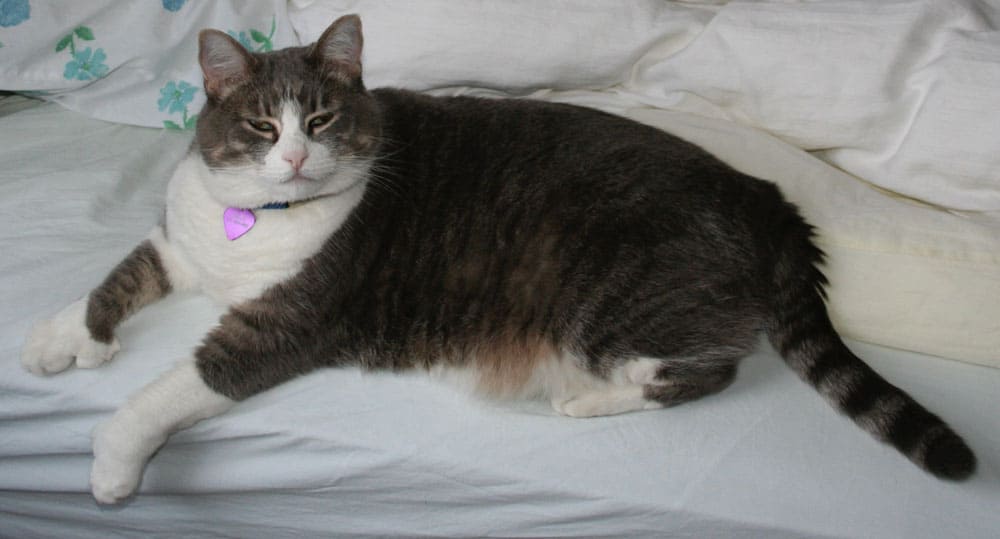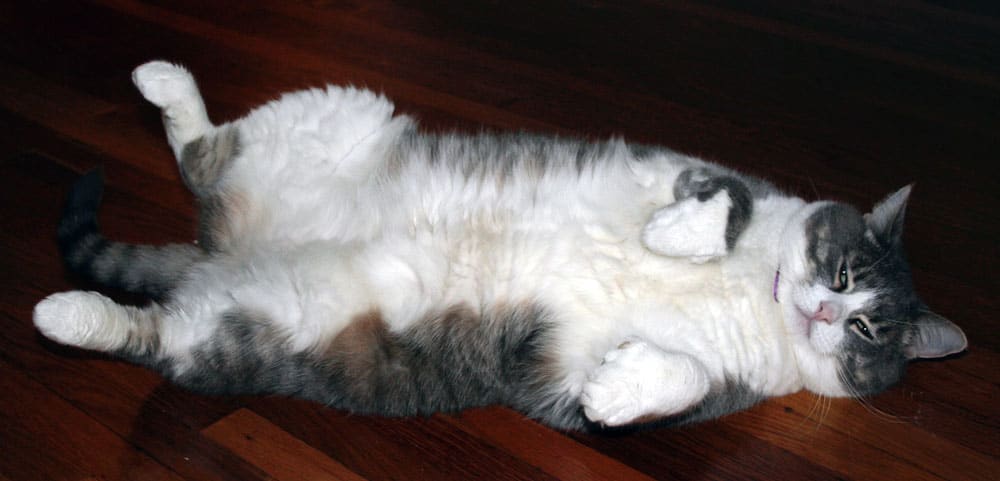Usually, most cats have four toes on the back and five toes on the front paws, but when it comes to polydactyl cats, they have six or seven toes (or more) on each. The word comes from Greek: “poly” meaning many and “daktulos” which means fingers.
While cats typically have 18 digits in total between the front and back paws, polydactyl cats can have as many as 28 toes, though most polydactyl cats have only a few extra toes.
Polydactylism in cats is the result of a genetic mutation
Polydactylism in cats is considered a benign genetic mutation. In this condition, the offspring are born with extra fingers. This genetic aberration is prevalent in a few different parts of the world, and it can happen with both males and female cats of any breed, large or little.
The genetic predisposition for polydactylism in cats is primarily attributed to an autosomal dominant gene. This means that the trait is not linked to the sex chromosomes, and only one copy of the gene needs to be present for the trait to manifest.
The most common form in cats is ‘preaxial polydactylism,’ where extra digits are situated on the side of the limb that corresponds with the thumb in humans. Another less common form is ‘postaxial polydactylism,’ where extra digits appear on the outer or ‘pinky’ side of the paw.
What impact does genetic mutation have on polydactyl cats?
The genetic mutation usually occurs in a dominant gene in polydactyl cats. Which in term produces the greater number of toes in cats, affected cats can have a number of toes between 4 and 7 on their front or rear legs.
In most cases, it is seen that generally, the front paws are affected more frequently, but it doesn’t mean that the back leg will not get affected by polydactylism. In some cases, the polydactyl is also seen to affect all paws on a cat, but it is not that common.

Extra digits usually come with additional musculature and ligaments, altering the biomechanics of how a cat walks, grips, or climbs. However, these differences are generally subtle and don’t tend to impede the cat’s locomotion or quality of life.
Polydactylism is generally thought to have no influence on your cat’s well-being or health, hence it is regarded as a harmless mutation. Having more fingers than usual has only one drawback in particular: it makes nail clipping more difficult. Unlike a cat with a normal amount of toes, the claws on the extra digits can often curl into the skin of the adjacent paws and become embedded. It’s important to keep those extra claws cut back to prevent this painful condition.
What is the difference between polydactylism and feline radial hypoplasia?
With feline radial hypoplasia you will also see the development of extra new toes. But the difference between those two terms is the immediate development of new toes alongside the feline’s usual toes that can result in extra-large, flat feet. If the cat is raised with radial hypoplasia, this can result in severe leg deformities in future new generations.
Because many individuals conflate the phrases polydactyl and feline radial hypoplasia, it would be helpful if you kept in mind that the two are completely different. Feline radial hypoplasia can have a negative impact on your cat’s health and is thought to be quite dangerous.
What are “mittens” in polydactyl cats?
Some polydactyl cats are seen with mitten paws. This can only happen if the extra toes appear in the middle of your cat’s claw, giving it a mitten or thumb appearance. The extra fingers resemble the thumbs, but they should not oppose each other.

Superstitions about polydactyl cats
Polydactyl cats are also considered lucky cats by some and are believed as a good luck for travelers and sailors. Because of this, polydactyl cats were also brought along on long ship trips.
The extra digits broaden their paw, allowing them to keep the ship’s supplies vermin-free and clean the ship of mice. Their large paws also aid in their balance during rocky times onboard the ship
Prevalence of polydactyl cats
As they are considered the lucky charm for sailors, they are mainly found in Canada, Wales, the eastern United States and England. The prevalence of polydactyl cats in those areas is often attributed to their time on transcontinental ships.
It is widely believed that in England, polydactyl cats were bred with non-polydactyl cats. They were transported across the Atlantic Ocean, and this is how their genetic traits proliferate.
Why polydactyl is prevalent in Maine Coon cats?
Maine, which is known for its harsh, snowy climate, is the birthplace of this cat species. With time, these cats developed large, insulated feet that serve as miniature snowshoes.
Maine Coons are the most prevalent polydactyl cats, accounting for about 40% of all unregistered Maine Coons. Polydactylism gave the Maine Coon wider paws, which helped them get through the tough, snowy conditions.
Hemingway’s six-toed cats
You may have heard of them as Hemingway’s cats. Ernest Hemingway had great affection the polydactyl cats. He was given a white cat named Snow Ball by the captain of a ship and that cat happen to be polydactyl.
After the death of Hemingway in 1961, his residence was converted into a home for his lovely cats and a museum in Key West, Florida. Now-a-days, the kitten colony has about 50 family members of the creative pack of cats, and nearly half of those cats are polydactyl.
As for presidential cats, Theodore Roosevelt owned a polydactyl cat named Slippers, so named because of his six toes. Beloved by the president, Slippers was know for showing up at important dinners at the White House.

Which cat holds the world record for most toes?
There’s an orange cat named Jake who is polydactyl. His name is written in Guinness Book of World Records, as a cat for having the maximum toes on the planet. He has 7 toes on each paw and having a total of 28 toes.
References
Hamelin, A., Begon, D., Conchou, F., Fusellier, M., & Abitbol, M. (2017). Clinical characterisation of polydactyly in Maine Coon cats. Journal of feline medicine and surgery, 19(4), 382-393. https://doi.org/10.1177/1098612X16628920
Hamelin, A., Conchou, F., Fusellier, M., Duchenij, B., Vieira, I., Filhol, E., … & Abitbol, M. (2020). Genetic heterogeneity of polydactyly in Maine Coon cats. Journal of feline medicine and surgery, 22(12), 1103-1113.
Polydactyl cats. (2019, September 24). Catwatch Newsletter – Cornell University. https://www.catwatchnewsletter.com/features/polydactyl-cats/
Polydactyl cats: An amazing genetic mutation. (2018, January 12). FloridaWild Vet Hospital. https://www.catwatchnewsletter.com/features/polydactyl-cats/
Our cats — The Hemingway home & Museum. (n.d.). The Hemingway Home & Museum. https://www.hemingwayhome.com/our-cats
This article was originally written on August 7, 2021 and has since been updated.






